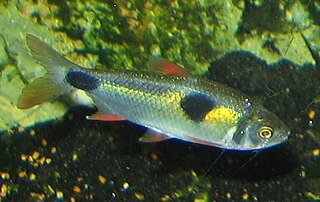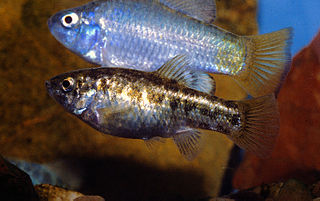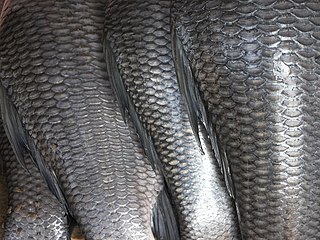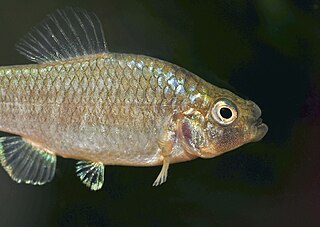
In evolutionary biology, adaptive radiation is a process in which organisms diversify rapidly from an ancestral species into a multitude of new forms, particularly when a change in the environment makes new resources available, alters biotic interactions or opens new environmental niches. Starting with a single ancestor, this process results in the speciation and phenotypic adaptation of an array of species exhibiting different morphological and physiological traits. The prototypical example of adaptive radiation is finch speciation on the Galapagos, but examples are known from around the world.

The Tecopa pupfish is an extinct subspecies of the Amargosa pupfish. The small, heat-tolerant pupfish was endemic to the outflows of a pair of hot springs in the Mojave Desert of Inyo County, California. Habitat modifications, the introduction of non-native species and hybridization with the related Amargosa River pupfish led to its extinction around 1979.

The Devils Hole pupfish is a critically endangered species of the family Cyprinodontidae (pupfishes) found only in Devils Hole, a water-filled cavern in the US state of Nevada. It was first described as a species in 1930 and is most closely related to C. nevadensis and the Death Valley pupfish. The age of the species is unknown, with differing analyses offering ranges between one thousand and sixty thousand years. It is a small fish, with maximum lengths of up to 30 mm (1.2 in). Individuals vary in coloration based on age and sex: males are bright metallic blue while females and juveniles are more yellow. A defining trait of this species is its lack of pelvic fins. The pupfish consumes nearly every available food resource at Devils Hole, including beetles, snails, algae, and freshwater crustaceans, with diet varying throughout the year. It is preyed on by the predaceous diving beetle species Neoclypeodytes cinctellus, which was first observed in Devils Hole in 1999 or 2000. Reproduction occurs year-round, with spikes in the spring and fall. Females produce few eggs, though, and the survivorship from egg to adult is low. Individuals live 10–14 months.

Pupfish are a group of small killifish belonging to ten genera of the family Cyprinodontidae of ray-finned fish. Pupfish are especially noted for being found in extreme and isolated situations. They are primarily found in North America, South America, and the Caribbean region, but Aphanius species are from southwestern Asia, northern Africa, and southern Europe. As of August 2006, 120 nominal species and 9 subspecies were known. Several pupfish species are extinct and most extant species are listed. In the U.S., the most well-known pupfish species may be the Devils Hole pupfish, native to Devils Hole on the Nevada side of Death Valley National Park. Since 1995 the Devils Hole pupfish has been in a nearly steady decline, where it was close to extinction at 35–68 fish in 2013.

Cyprinodon is a genus of pupfishes found in waters that range from fresh to hypersaline. The genus is primarily found in Mexico, the Caribbean Islands and southern United States, but C. variegatus occurs as far north as Massachusetts and along the entire Gulf of Mexico coastline, and C. dearborni and C. variegatus are found in northern South America. Many species have tiny ranges and are highly threatened, in some cases already extinct. Cyprinodon are small; the largest reaches 10 cm (3.9 in) in length and most other species only reach about half that size.

Lepidophagy is a specialised feeding behaviour in fish that involves eating the scales of other fish. Lepidophagy is widespread, having evolved independently in at least five freshwater families and seven marine families. A related feeding behavior among fish is pterygophagy: feeding on the fins of other fish.
Blackfin pupfish is a species of fish in the family Cyprinodontidae. This pupfish is endemic to Lake Chichancanab in Quintana Roo, Mexico. In almost all places, different Cyprinodon species do not overlap in their range, but there are two notable exceptions and one of these is Lake Chichancanab, which is inhabited by C. beltrani, C. esconditus, C. labiosus, C. maya, C. simus, C. suavium and C. verecundus. Among the endemic Cyprinodon species in Lake Chichancanab, only C. beltrani and C. labiosus still occur in some numbers in their habitat, while the remaining are virtually—if not fully—extinct in the wild. This species feeds on detritus. Compared to the other species of pupfish mentioned previously, the C. beltrani prefer a different feeding substrate. In regards to mating, the female blackfin pupfish seems to mate with other species of pupfish and not just the C. beltrani. The male blackfin pupfish have similar markings and courting behaviors to other pupfish in their habitat. The person honored in the specific name of this pupfish is the Mexican biologist Enrique Beltrán Castillo (1903–1994) to mark his quarter century of being a biologist.

The Comanche Springs pupfish is a species of pupfish in the family Cyprinodontidae. It is endemic to Texas, and is now found only in spring-fed pools near Balmorhea, a small town in West Texas.
The thicklip pupfish, known in Spanish as Cachorrito cangrejero, is a species of fish in the family Cyprinodontidae. The thicklip pupfish is endemic to Laguna Chichancanab in Quintana Roo, Mexico. In almost all places, different Cyprinodon species do not overlap in their range, but there are two notable exceptions and one of these is Lake Chichancanab, which is inhabited by C. labiosus, C. beltrani, C. esconditus, C. maya, C. simus, C. suavium and C. verecundus. Among the endemic Cyprinodon species in Lake Chichancanab, only C. beltrani and C. labiosus still occur in some numbers in their habitat, while the remaining are virtually—if not fully—extinct in the wild. They usually live in a tropical climate with temperatures ranging from 22 to 26 °C. The maximum total length of this fish is 7 centimetres (2.8 in).
The Maya pupfish, known in Spanish as cachorrito gigante, is a highly threatened species of fish in the family Cyprinodontidae. It is endemic to Lake Chichancanab in Quintana Roo, Mexico. In almost all places, different Cyprinodon species do not overlap in their range, but there are two notable exceptions and one of these is Lake Chichancanab, which is inhabited by C. maya, C. beltrani, C. esconditus, C. labiosus, C. simus, C. suavium and C. verecundus. Living together, the Cyprinodon species in Lake Chichancanab have diverged into different niches. Pupfish typically feed on algae and detritus. In Lake Chichancanab, however, C. maya has become not only the largest species in the genus Cyprinodon, up to 10 cm (3.9 in) long, but also the only that catches and eats whole fish. In smaller quantities it eats ostracods and freshwater snails.

The Pecos pupfish is a species of pupfish in the family Cyprinodontidae. It is endemic to the Pecos River watershed in eastern New Mexico and western Texas in the United States.
The boxer pupfish is a small species of pupfish in the family Cyprinodontidae. It is endemic to Lake Chichancanab in Quintana Roo, Mexico.
The largefin pupfish, also known as cachorrito de dorsal larga, is a small species of pupfish in the family Cyprinodontidae. It is endemic to Lake Chichancanab in Quintana Roo, Mexico. In almost all places, different Cyprinodon species do not overlap in their range, but there are two notable exceptions and one of these is Lake Chichancanab, which is inhabited by C. verecundus, C. beltrani, C. esconditus, C. labiosus, C. maya, C. simus and C. suavium. Living together, the Cyprinodon species in Lake Chichancanab have diverged into different niches. Pupfish typically feed on algae and detritus. In Lake Chichancanab, however, C. verecundus has become an amphipod- and bivalve-eater.

The Catarina pupfish was a diminutive species of fish in the family Cyprinodontidae, first described in 1972. It was endemic to a spring in Nuevo León, Mexico. In an attempt of saving the rapidly declining species, some were brought into captivity in the late 1980s and early 1990s, but it proved very difficult to maintain. In 1994 it became extinct in the wild. Gradually the captive populations also perished. The last male died in 2014 and the species became extinct.

The desert pupfish is a rare species of bony fish in the family Cyprinodontidae. It is a small fish, typically less than 7.62 cm (3 in) in length. Males are generally larger than females, and have bright-blue coloration, while females and juveniles are silvery or tan. A notable attribute of the desert pupfish is their ability to survive in environments of extreme salinity, pH, and temperature, and low oxygen content. The desert pupfish mates in a characteristic fashion, wherein compatible males and females will come in contact and collectively jerk in an s-shape. Each jerk typically produces a single egg that is fertilized by the male and deposited in his territory. Breeding behavior includes aggressive arena-breeding and more docile consort-pair breeding.

A fish scale is a small rigid plate that grows out of the skin of a fish. The skin of most jawed fishes is covered with these protective scales, which can also provide effective camouflage through the use of reflection and colouration, as well as possible hydrodynamic advantages. The term scale derives from the Old French escale, meaning a shell pod or husk.
Cyprinodon arcuatus is a species of fish in the family Cyprinodontidae. It was endemic to the Santa Cruz River in Arizona. It has been declared extinct as of 2011.

Cyprinodon brontotheroides is a species of pupfish in the genus Cyprinodon.

The Hispaniola pupfish is a fish endemic to the lakes of Etang Saumâtre and Lake Enriquillo on the island of Hispaniola, in both Haiti and the Dominican Republic.
Lake Chichancanab from Yucatec Maya "Little Sea" is a lake in Mexico located in the northwest of the state of Quintana Roo, in the municipality of José María Morelos. It is also known as Laguna Chichancanab, Laguna Chicnancanab and Laguna de Chichancanab. It has an approximate length of 30 kilometers from near the settlement of La Presumida to that of Kantemó, in the same municipality. It is the largest lake on the Yucatan Peninsula.














